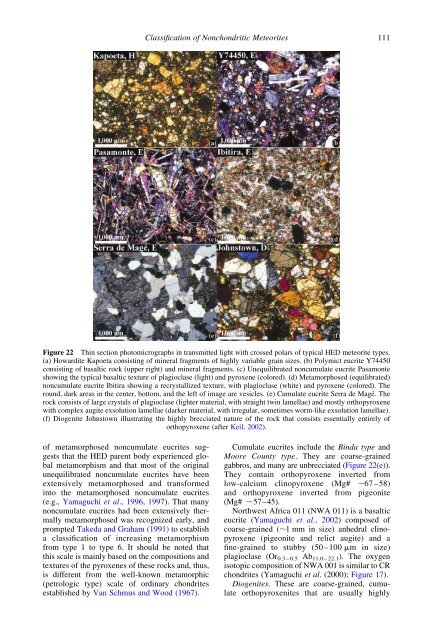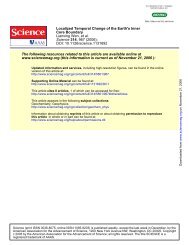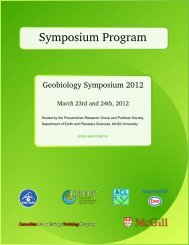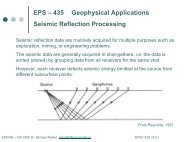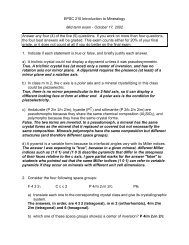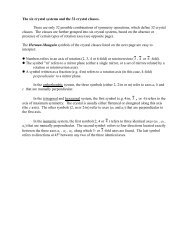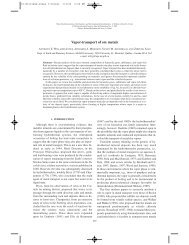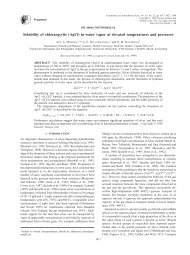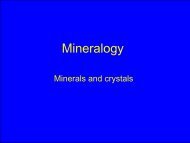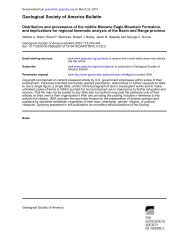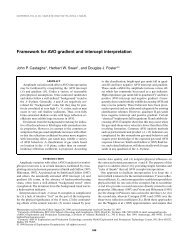05 Classification of.. - Department of Earth and Planetary Sciences
05 Classification of.. - Department of Earth and Planetary Sciences
05 Classification of.. - Department of Earth and Planetary Sciences
Create successful ePaper yourself
Turn your PDF publications into a flip-book with our unique Google optimized e-Paper software.
<strong>Classification</strong> <strong>of</strong> Nonchondritic Meteorites 111<br />
Figure 22 Thin section photomicrographs in transmitted light with crossed polars <strong>of</strong> typical HED meteorite types.<br />
(a) Howardite Kapoeta consisting <strong>of</strong> mineral fragments <strong>of</strong> highly variable grain sizes. (b) Polymict eucrite Y74450<br />
consisting <strong>of</strong> basaltic rock (upper right) <strong>and</strong> mineral fragments. (c) Unequilibrated noncumulate eucrite Pasamonte<br />
showing the typical basaltic texture <strong>of</strong> plagioclase (light) <strong>and</strong> pyroxene (colored). (d) Metamorphosed (equilibrated)<br />
noncumulate eucrite Ibitira showing a recrystallized texture, with plagioclase (white) <strong>and</strong> pyroxene (colored). The<br />
round, dark areas in the center, bottom, <strong>and</strong> the left <strong>of</strong> image are vesicles. (e) Cumulate eucrite Serra de Magé. The<br />
rock consists <strong>of</strong> large crystals <strong>of</strong> plagioclase (lighter material, with straight twin lamellae) <strong>and</strong> mostly orthopyroxene<br />
with complex augite exsolution lamellae (darker material, with irregular, sometimes worm-like exsolution lamellae).<br />
(f) Diogenite Johnstown illustrating the highly brecciated nature <strong>of</strong> the rock that consists essentially entirely <strong>of</strong><br />
orthopyroxene (after Keil, 2002).<br />
<strong>of</strong> metamorphosed noncumulate eucrites suggests<br />
that the HED parent body experienced global<br />
metamorphism <strong>and</strong> that most <strong>of</strong> the original<br />
unequilibrated noncumulate eucrites have been<br />
extensively metamorphosed <strong>and</strong> transformed<br />
into the metamorphosed noncumulate eucrites<br />
(e.g., Yamaguchi et al., 1996, 1997). That many<br />
noncumulate eucrites had been extensively thermally<br />
metamorphosed was recognized early, <strong>and</strong><br />
prompted Takeda <strong>and</strong> Graham (1991) to establish<br />
a classification <strong>of</strong> increasing metamorphism<br />
from type 1 to type 6. It should be noted that<br />
this scale is mainly based on the compositions <strong>and</strong><br />
textures <strong>of</strong> the pyroxenes <strong>of</strong> these rocks <strong>and</strong>, thus,<br />
is different from the well-known metamorphic<br />
(petrologic type) scale <strong>of</strong> ordinary chondrites<br />
established by Van Schmus <strong>and</strong> Wood (1967).<br />
Cumulate eucrites include the Binda type <strong>and</strong><br />
Moore County type. They are coarse-grained<br />
gabbros, <strong>and</strong> many are unbrecciated (Figure 22(e)).<br />
They contain orthopyroxene inverted from<br />
low-calcium clinopyroxene (Mg# ,67–58)<br />
<strong>and</strong> orthopyroxene inverted from pigeonite<br />
(Mg# ,57–45).<br />
Northwest Africa 011 (NWA 011) is a basaltic<br />
eucrite (Yamaguchi et al., 2002) composed <strong>of</strong><br />
coarse-grained (,1 mm in size) anhedral clinopyroxene<br />
(pigeonite <strong>and</strong> relict augite) <strong>and</strong> a<br />
fine-grained to stubby (50–100 mm in size)<br />
plagioclase (Or 0.3 – 0.5 Ab 11.0 – 22.1 ). The oxygen<br />
isotopic composition <strong>of</strong> NWA 001 is similar to CR<br />
chondrites (Yamaguchi et al. (2000); Figure 17).<br />
Diogenites. These are coarse-grained, cumulate<br />
orthopyroxenites that are usually highly


